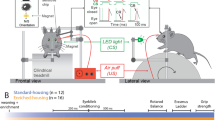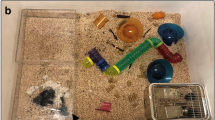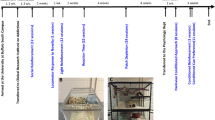Abstract
Environmental enrichment for animals is a combination of complex inanimate and social stimulation and generally consists of housing conditions that facilitate enhanced sensory, cognitive, motor and social stimulation relative to standard housing conditions. One of the most robust effects of environmental enrichment is the reduction of anxiety levels. However, the extreme variability in enrichment protocols may account for some of the inconsistencies in its effects and the variance among results reported by different laboratories. In this protocol, we describe a simple environmental enrichment strategy for the induction of a robust and replicable anxiolytic-like effect in mice. We provide detailed instructions on how to build an enrichment cage that is specially designed for easy manipulation, cleaning and observation by the experimenter. In addition, we describe the different enrichment items, their order in the cage, the frequency of renewal and their cleaning and sterilization procedures. The total length of the protocol is 6 weeks.
This is a preview of subscription content, access via your institution
Access options
Subscribe to this journal
Receive 12 print issues and online access
$259.00 per year
only $21.58 per issue
Buy this article
- Purchase on Springer Link
- Instant access to full article PDF
Prices may be subject to local taxes which are calculated during checkout



Similar content being viewed by others
References
Rosenzweig, M.R. et al. Social grouping cannot account for cerebral effects of enriched environments. Brain Res. 153, 563–576 (1978).
Rosenzweig, M.R. Environmental complexity, cerebral change, and behavior. Am. Psychol. 21, 321–332 (1966).
Rosenzweig, M.R. & Bennett, E.L. Effects of differential environments on brain weights and enzyme activities in gerbils, rats, and mice. Dev. Psychobiol. 2, 87–95 (1969).
van Praag, H., Kempermann, G. & Gage, F.H. Neural consequences of environmental enrichment. Nat. Rev. Neurosci. 1, 191–198 (2000).
Nithianantharajah, J. & Hannan, A.J. Enriched environments, experience-dependent plasticity and disorders of the nervous system. Nat. Rev. Neurosci. 7, 697–709 (2006).
Fox, C., Merali, Z. & Harrison, C. Therapeutic and protective effect of environmental enrichment against psychogenic and neurogenic stress. Behav. Brain Res. 175, 1–8 (2006).
Kempermann, G., Kuhn, H.G. & Gage, F.H. More hippocampal neurons in adult mice living in an enriched environment. Nature 386, 493–495 (1997).
Rampon, C. et al. Enrichment induces structural changes and recovery from nonspatial memory deficits in CA1 NMDR1-knockout mice. Nat. Neurosci. 3, 238–244 (2000).
Rampon, C. & Tsien, J.Z. Genetic analysis of learning behavior-induced structural plasticity. Hippocampus 10, 605–609 (2000).
Sale, A., Beradi, N. & Maffei, L. Enrich the environment to empower the brain. Trends Neurosci. 32, 233–239 (2009).
Mohammed, A.H. et al. Environmental enrichment and the brain. Prog. Brain Res. 138, 109–133 (2002).
Van de Weerd, H.A. et al. Effects of environmental enrichment for mice: variation in experimental results. J. Appl. Anim. Welf. Sci. 5, 87–109 (2002).
Sztainberg, Y., Kuperman, Y., Tsoory, M., Lebow, M. & Chen, A. The anxiolytic effect on environmental enrichment is mediated via amygdalar CRF receptor type 1. Mol. Psychiatry advance online publication, doi:10.1038/mp.2009.151 (19 January 2010).
McOmish, C.E. & Hannan, A.J. Enviromimetics: exploring gene-environment interactions to identify therapeutic targets for brain disorders. Expert Opin. Ther. Targets 11, 899–813 (2007).
van Praag, H., Christie, B.R., Sejnowski, T.J. & Gage, F.H. Running enhances neurogenesis, learning, and long-term potentiation in mice. Proc. Natl Acad. Sci. USA 96, 13427–13431 (1999).
van Praag, H., Kempermann, G. & Gage, F.H. Running increases cell proliferation and neurogenesis in the adult mouse dentate gyrus. Nat. Neurosci. 2, 266–270 (1999).
Olson, A.K., Eadie, B.D., Ernst, C. & Christie, B.R. Environmental enrichment and voluntary exercise massively increase neurogenesis in the adult hippocampus via dissociable pathways. Hippocampus 16, 250–260 (2006).
Van Loo, P.L., Van de Weerd, H.A., Van Zutphen, L.F. & Baumans, V. Preference for social contact versus environmental enrichment in male laboratory mice. Lab. Anim. 38, 178–188 (2004).
Van de Weerd, H.A., Van Loo, P.L.P., Van Zutphen, L.F.M., Koolhaas, J.M. & Baumans, V. Strength of preference for nesting material as environmental enrichment for laboratory mice. Appl. Anim. Behav. Sci. 55, 369–382 (1998).
Lisk, R.D., Pretlow, R.A. & Friedman, S.M. Hormonal stimulation necessary for elicitation of maternal nest-building in the mouse (Mus musculus). Anim. Behav. 17, 730–737 (1969).
Olsson, I.A. & Dahlborn, K. Improving housing conditions for laboratory mice: a review of 'environmental enrichment'. Lab. Anim. 36, 243–270 (2002).
Van Loo, P.L.P., Van Zutphen, L.F.M. & Baumans, V. Male management: coping with aggression problems in male laboratory mice. Lab. Anim. 37, 300–313 (2003).
Deacon, R.M.J. Housing, husbandry and handling of rodents for behavioral experiments. Nat. Protoc. 1, 936–946 (2006).
Solinas, M., Chauvet, C., Thiriet, N., El Rawas, R. & Jaber, M. Reversal of cocaine addiction by environmental enrichment. Proc. Natl Acad. Sci. USA 105, 17145–17150 (2008).
Benaroya-Milshtein, N. et al. Environmental enrichment in mice decreases anxiety, attenuates stress responses and enhances natural killer cell activity. Eur. J. Neurosci. 20, 1341–1347 (2004).
La Torre, J.C. Effect of differential environmental enrichment on brain weight and on acetylcholinesterase and cholinesterase activities in mice. Exp. Neurol. 22, 493–503 (1968).
Banjanin, S. & Mrosovsky, N. Preferences of mice, Mus musculus, for different types of running wheel. Lab. Anim. 34, 313–318 (2000).
Moncek, F., Duncko, R., Johansson, B.B. & Jezova, D. Effect of environmental enrichment on stress related systems in rats. J. Neuroendocrinol. 16, 423–431 (2004).
Van Loo, P.L.P., Blom, H.J., Meijer, M.K. & Baumans, V. Assessment of the use of two commercially available environmental enrichments by laboratory mice by preference testing. Lab. Anim. 39, 58–67 (2005).
Kostomitsopoulos, N.G. et al. The influence of the location of a nest box in an individually ventilated cage on the preference of mice to use it. J. Appl. Anim. Welf. Sci. 10, 111–121 (2007).
Amaral, O.B., Vargas, R.S., Hansel, G., Izquierdo, I. & Souza, D.O. Duration of environmental enrichment influences the magnitude and persistence of its behavioral effects on mice. Physiol. Behav. 93, 388–394 (2008).
Sherwin, C.M. Comfortable quarters for mice in research institutions. In Comfortable Quarters for Laboratory Animals (eds. Reinhardt, V. & Reinhardt, A.) Animal Welfare Institute, Washington, DC, (2002).
Walf, A.A. & Frye, C.A. The use of the elevated plus maze as an assay of anxiety-related behavior in rodents. Nat. Protoc. 2, 322–328 (2007).
Bourin, M. & Hascoet, M. The mouse light/dark box test. Eur. J. Pharmacol. 463, 55–65 (2003).
National Research Council. Guide for the care and use of laboratory animals. National Academy Press, Washington, DC. (1996).
Acknowledgements
We thank B. Pasmantirer and G. Perelman from the Weizmann Institute of Science Instrument Design Unit for the design of the EE cage and A. Inhorn from the Weizmann Institute of Science Precision Instrument and Engineering Workshop for the construction of the EE cage.
Author information
Authors and Affiliations
Contributions
Y.S. prepared and wrote the article. A.C. supervised and edited the article.
Corresponding author
Ethics declarations
Competing interests
The authors declare no competing financial interests.
Supplementary information
Supplementary Data
Detailed plans for the construction of an EE cage (PDF 2421 kb)
Rights and permissions
About this article
Cite this article
Sztainberg, Y., Chen, A. An environmental enrichment model for mice. Nat Protoc 5, 1535–1539 (2010). https://doi.org/10.1038/nprot.2010.114
Published:
Issue Date:
DOI: https://doi.org/10.1038/nprot.2010.114
This article is cited by
-
Effects of social housing conditions on ethanol-induced behavioral sensitization in Swiss mice
Psychopharmacology (2024)
-
Housing conditions modify seasonal changes in basal metabolism and body mass of the Siberian hamster, Phodopus sungorus
Journal of Comparative Physiology B (2022)
-
Environmental enrichment influences novelty reactivity, novelty preference, and anxiety via distinct genetic mechanisms in C57BL/6J and DBA/2J mice
Scientific Reports (2021)
-
Apparatus design and behavioural testing protocol for the evaluation of spatial working memory in mice through the spontaneous alternation T-maze
Scientific Reports (2021)
-
Tactile modulation of memory and anxiety requires dentate granule cells along the dorsoventral axis
Nature Communications (2020)
Comments
By submitting a comment you agree to abide by our Terms and Community Guidelines. If you find something abusive or that does not comply with our terms or guidelines please flag it as inappropriate.



